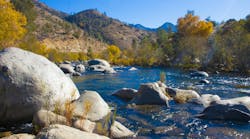New Hampshire awards grant for sodium chloride-based watershed restoration plan
The New Hampshire Department of Environment Services (NHDES) announced a Watershed Assistance Grant to the Merrimack Village District for a first-of-its-kind project to develop a sodium chloride-based watershed restoration plan.
The $80,000 grant comes through the NHDES Nonpoint Source Management and Drinking Water Source Protection Programs.
In December 2022, NHDES issued a solicitation for projects addressing nonpoint source (NPS) pollution through the development of a NaCl (sodium chloride)-based watershed restoration plan in a priority, water supply watershed that has a documented sodium and/or chloride impairment.
Projects were ranked based on criteria including the waterbody’s drinking water quality and severity of NaCl impairment(s); the level of public participation and commitment to the project; relative value or significance of the water body or water resources; and the quality of the proposal. Based on the specified selection criteria and the amount of grant funding available, the highest ranked proposal was selected for funding.
The Merrimack Village District’s (MVD’s) "Naticook Brook Watershed/ Litchfield Tributaries Watershed Management Plan" project was selected for a $80,000 Watershed Assistance Grant (WAG) funded through the Bipartisan Infrastructure Law (BIL) State Revolving Loan Fund program.
The MVD provides potable drinking water to approximately 9,300 customers from a series of high-capacity water supply wells, three of which are within the Naticook Brook watershed (MVD-2, MVD-3 and MVD-9). The Naticook Brook watershed contains paved roads, parking lots and other impervious surfaces that require significant winter maintenance in the form of plowing, sanding and salt application.
Associated runoff and infiltration into surface and groundwater resources is causing significant salt contamination of streams, rivers, ponds, lakes and wetlands within the watershed. While all three public water supply wells in the Naticook Brook watershed have experienced increasing sodium and chloride concentrations, MVD-3 has been exceptionally impacted.
Since 1992, the chloride concentrations in MVD-3 have increased by an order of magnitude. The impacts from salt runoff in this watershed has led to MVD-3 consistently being above the secondary maximum contaminant level (SMCL) for chloride (SMCL of 250 mg/L), causing the well to be taken offline as a public water supply.
The watershed-based plan funded through this grant agreement will evaluate winter salt use throughout the Naticook Brook source water protection area to develop a sector load allocation for salt and priority-based reduction goals for surface and groundwater paired with recommended best management practices (BMPs) to be implemented to achieve reduction goals.
The watershed-based plan will recommend a series of actions for project partners (municipal, state, private, commercial and/or nonprofit, etc.) with the intention of meeting the watershed-based plan salt reduction goals within ten years. This will be the first watershed-based plan in New Hampshire where sodium chloride is identified as the target pollutant impacting both surface and groundwater resources.
In the past 50 years, winter salt application on New Hampshire roads, parking lots, sidewalks and other paved surfaces to ensure the safety of the traveling public has increased significantly. The most commonly used substance to de-ice these surfaces is rock salt, or sodium chloride (NaCl). While the use of winter salt provides New Hampshire residents with safe travel, another legacy of this long-term practice is polluted surface and groundwater throughout the state.
Elevated sodium levels can affect drinking water taste and high levels of chloride are corrosive which can lead to the leaching of metals from plumbing systems. Chloride, which is toxic to aquatic life at certain thresholds, is highly soluble and mobile in groundwater. Often there is enough dilution in spring melt water to keep chlorides below impairment levels, but when dilutions are not enough, particularly in smaller streams and in lakes and ponds during summer months, surface waters become impaired and drinking water wells are abandoned due to contamination.
At this time, the only way to prevent chloride from reaching surface and groundwater is to reduce the amount applied to roadways, parking lots and sidewalks without compromising safety. The NHDES Green SnowPro Program offers snow and ice management professionals training and certification in state of the art salt reduction practices that prioritize public safety while mitigating salt usage.


